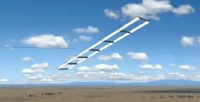Joby Energy in California is testing kites flying at an average height of 400m (1,300ft) – around five times the height of a ground-based turbine – where winds are faster and more consistent.
The first prototypes can produce up to 30kW of power, but the firm is developing a system that is designed provide between 300kW and 3MW – enough to supply up to 1,500 US homes. It hopes to begin manufacturing in 2012.
The modular kites can be built with five tons of material per MW produced, compared to nearly 100 tons for conventional wind turbines, giving them a capital cost of under $1 (£0.7) per watt.

Although air is thinner at higher altitudes, meaning lower power density, winds are much faster because of the lack of obstacles and friction from the ground. This means that overall power density is much higher.
A spokesperson from Joby told The Engineer: ‘By tapping in to the more powerful winds, our system can produce twice the amount of energy as a ground-based wind turbine of the same capacity.
‘Based on our analysis, the levelised cost of energy delivered from our airborne wind-energy systems will be $0.04 per kWh.’
The kites fly in a circular motion and a 3MW system would need 2km2 of ground space around the tether.
Joby is looking for test sites outside air-traffic corridors in Ireland, California, the Midwestern US and island nations that currently pay very high electricity rates.
Onboard battery-powered computer controls allow the kites to land themselves during extreme weather conditions, or if the tether is severed, and multiple motors provide a backup if one motor fails.
Other companies experimenting with airborne power generation include Sky Windpower, which is building flying generators, and Magenn Power, which uses a helium blimp to carry turbines.
The three firms, along with Makani Power, have formed the Airborne Wind Energy Consortium to address policy, regulatory and technical challenges.
It will hold the Airborne Wind Energy 2010 Conference at Stanford University on September 28 and 29, co-sponsored by NASA.





Red Bull makes hydrogen fuel cell play with AVL
Formula 1 is an anachronistic anomaly where its only cutting edge is in engine development. The rules prohibit any real innovation and there would be...